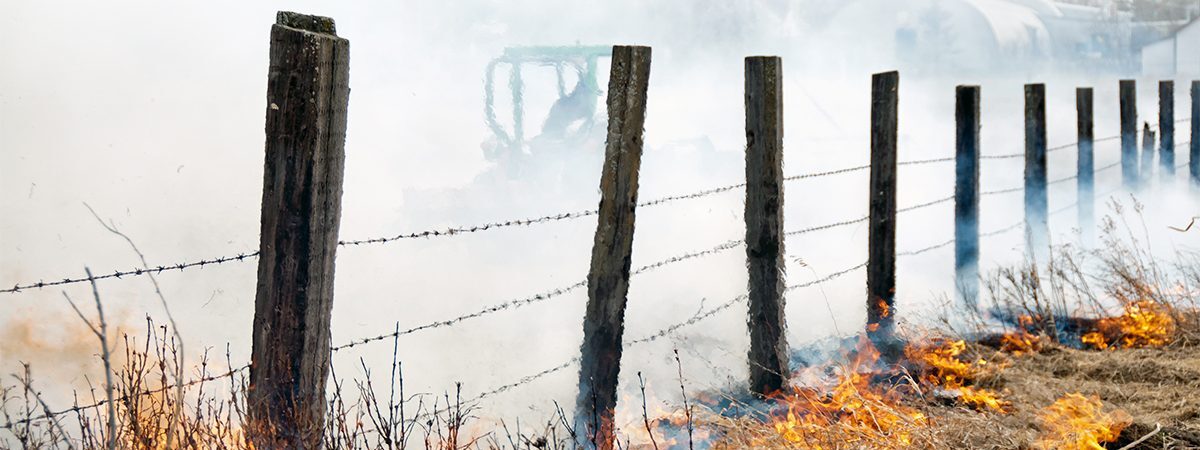AB Direct - Steers
Rail: ---
AB Direct - Heifers
Rail: ---
US Trade- Steers
Rail: ---
US Trade - Heifers
Rail: ---
Canadian Dollar
0.19

Fire safety tips for farmyards and pastures
Farm infrastructure and feedstock fires can be devastating. Careful planning reduces the risk.
Prairie summers bring heat, thunderstorms, and bugs, but unfortunately, the season also comes with the risk of forest, grass, and farmyard fires.
Brad Andres, Director of Emergency Management Services at Alberta Agriculture and Irrigation explains the standard three steps of ‘Personal Preparedness’: knowing the risks, making a plan, and assembling a kit, also relates to keeping summer fires from destroying property and infrastructure.
“In the farming and ranching community, understanding the context of the risk in relation to where you live is important,” he says. “We encourage producers and organizations to take a holistic view of their entire operation and assets and identify the biggest risks affecting them.”
Risks vary. For example, farms near forests, rivers, or open terrain will have a unique operational view of fire safety.
Two-Part Strategies
Andres suggests operations focus their fire prevention strategies on two groups:
- The people living and working at the site.
- The domesticated animals.
Human lives come first
“We reinforce human safety is number one,” he says. “It’s unlikely a family unit will stop a large wildfire alone. Of course, we’re trying to stay and protect but we need to understand if we get hurt or worse, it will be hard to rebuild.”
It’s important to determine the line between staying to fight and evacuating to save human lives.
Animals need help too
Keeping cattle safe is also dependent on location and farm characteristics. For cow-calf operations in wooded areas, it’s wise to include a course of action for moving herds into empty fields for a better chance of survival. In grassland, the strategy might identify the gates to open to ensure drinking water plus having a cultivator nearby for plowing a fire barrier. Feedlots can’t realistically move hundreds or thousands of cattle off-site quickly so their animal protection plan might include moving entire pens to less risky areas with ponds or dugouts.
Apply home protection criteria to barns and feedstock inventories
Andres says the ‘three-zone’ home protection criteria also apply to barns, bale piles, and animal housing areas. “Keep the immediate space near these structures and facilities free from fuel sources such as wood, tall grass, refuse piles, deadfall, and bushes,” he says. “Planting deciduous rather than coniferous trees also helps limit hazards.”
Farmyard tips
- Keep welding and torching activities confined to concrete or gravel surfaces.
- Monitor burn barrel location and prevailing winds.
- Park ATVs and quads in fuel-free locations.
- Mow and remove cut grass from around shops and barns.
- Fill a water tank or barrel for easy bucket access.
- Keep fire extinguishers updated and accessible.
Out-of-the-box fire prevention tips
Brent Sanderson, County Deputy Fire Chief and Alberta FireSmart Coordinator agrees and emphasizes proactive tips for reducing yard and pasture fire risks.
- Follow municipality burning bylaws and regulations.
- Keep the equipment used for work or play in good order and clear of debris around exhaust and engine hotspots.
- Ensure larger firefighting vehicles can access property in the event of a fire. Leave gates unlocked.
- Mount a visible, fire-resistive farm address sign.
- Manage fence lines and ditches.
- Store bales away from structures and keep the ground between them maintained.
- Ask your insurance company about wildfire loss coverage.
- Be prepared and communicate your plan to everyone involved.
Depending on a farm’s footprint, creating fire breaks and moving livestock to safe areas will demand serious thought and planning.
How will you prepare yourself, your family, and your animals in case of a dangerous fire?


